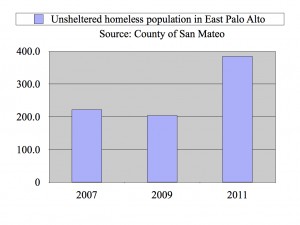Tim Gandy goes to work most days at Google, though he has never owned a computer or signed up for an email account.
He is a chef contracted to cook for the company’s creative minds in Mountain View. The job, which Gandy has held since September, is a long way from the previous six years of his life when he was homeless in San Francisco. He knows what it feels like to be considered “the dirt of the world,” his description of how some people regarded him back then.
[youtube]zt9X7azXil8[/youtube]
With a steady paycheck now, Gandy can afford to live in a Palo Alto transitional housing facility along with four other residents. The housing is arranged by Free At Last, an East Palo Alto nonprofit that provides outpatient and residential treatment programs for people recovering from drug addiction.

But as East Palo Alto’s homeless population has grown in recent years, it has become harder for people like Gandy to find a place to stay. A nighttime count of the homeless on Jan. 26, 2011, showed that the city’s unsheltered population who lived on streets, in vehicles and in homeless encampments had reached 385 — up 89 percent from the previous count done two years earlier. At least 10 percent of San Mateo County’s homeless population can be found in East Palo Alto, according to the count.
One explanation for why East Palo Alto’s number increased significantly may be that the 2011 survey was more accurate than previous ones, said Kate Bristol, a consultant who helped San Mateo County analyze the data. Bristol said last year was the first time the county partnered with local community activists to count the homeless. (The next count will be in 2013.)
The number may also be larger than it appears. Because East Palo Alto does not have a permanent shelter, some homeless people spend their days in the city but were counted at night in shelters and transitional housing in neighboring jurisdictions, such as Palo Alto, Menlo Park and Redwood City.
“We have always known that we had many homeless people in East Palo Alto,” said the Rev. Mary Frazier, who helped San Mateo County with the 2011 count. “This city has always had a low-income population, and of course the present economy has been bad for the last few years.”
Stanley Pollard, a former charter bus driver, blames his homelessness on the state’s drying education budget. “If there is no money to take the students,” Pollard said, “there is no money for the buses. No money for the buses, no money for me.” Unable to pay his rent, Pollard has been living in a recreational vehicle in East Palo Alto.
“Poverty is the overarching initiator for homelessness,” said Carol Lamont, East Palo Alto’s rent stabilization program administrator. The lower income of its residents has made the city more vulnerable to the loss of jobs than neighboring communities. In November, East Palo Alto had an unemployment rate of 17.6 percent, much higher than the nationwide rate of 8.6 percent then.

In response, East Palo Alto has hired Kate Bristol Consulting to develop a homeless solution plan. The consultants, who are using data analysis and focus groups, are expected to present the plan to city council members in March.
Patsy Caracter, who has worked with homeless people for more than 20 years, said what the city needs is a permanent shelter. She said the shelter should be a place where homeless people can go to use computers and have their mail delivered. “Sometimes, a bathroom can make a huge difference because (a potential employer) wouldn’t hire people if they are smelly,” Caracter said.
Frazier said the shelter should also employ case managers or social workers to help homeless people with job training, budgeting and medical care.
“Being homeless, people don’t have plans or visions about the future,” said Irma, who declined to give her last name. “What they think every day is what to eat tonight and where to sleep.” In her case, she said, a residential treatment program helped her to feel “stabilized,” and she has found a job. She lives in an apartment in Redwood City, but still goes to church in East Palo Alto.
Irma said her past experiences being homeless led her to work part-time for the County of San Mateo to assist homeless people with mental health issues.
In tight economic times, it could be difficult for East Palo Alto to fund its plans. But Lamont said, “The cost to our health system, welfare system and jails are much higher if we don’t help those people get into housing.”
Some homeless people such as former charter bus driver Pollard are still staying in their cars or tents, waiting for an opportunity to work again. “I don’t want a hand out. I just need a hand,” Pollard said. He then headed to his car and started the engine. The heat is one of the few comforts he can find this winter.
